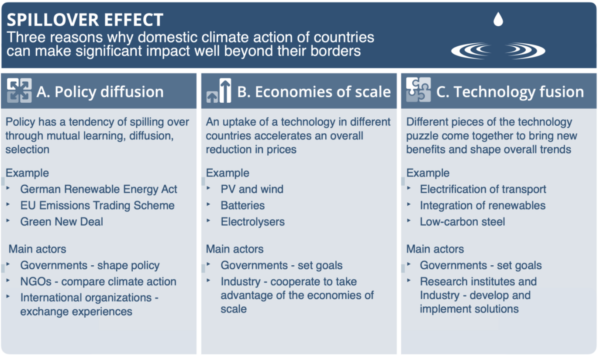Beyond borders: How to strengthen the external impact of domestic climate action
Authors
Share

Every country has an important role to play in increasing the ambition of domestic climate action in response to our collective climate crisis. This report looks at the main mechanisms and drivers for the uptake of climate policies beyond just the borders of the country implementing them.
The spillover effect of domestic action
No single country will be able to fix the issue of climate change on its own. However, every country has an important role to play in increasing the ambition of domestic climate action in response to our collective climate crisis.
The Paris Agreement, with its 1.5°C temperature limit and the obligation for countries to submit and implement successively more ambitious Nationally Determined Contributions (NDCs) every five years as part of achieving this goal, forms the basis for international cooperation in solving this crisis.
However, the level of ambition in NDC targets submitted to date by different countries, and the transposition of these targets into national laws and policies, varies significantly and in most cases is not consistent with 1.5°C pathways.
This inadequacy in ambition in many countries is used by some governments as an excuse not to increase their own level of climate action. This is often stated under the premise that their comparatively small contribution to climate change does not justify radical changes to their economy and the transformational action which is needed to address climate change (BiznesAlert, 2019; Climate Analytics, 2017; Focus, 2019; Wirtschaftsvereinigung Stahl, 2020).
Apart from ignoring the significant co-benefits of climate action, such as improved air quality, decreasing energy dependence, and job creation, waiting until other countries take action ignores the spillover effect one’s action can have on the policies of other countries. This spillover effect of policies and measures can result in overall emissions reductions that are much higher than those initially targeted by the domestic actions of that country. A good example of this effect is the adoption of the feed-in tariffs by many countries following the success of this policy in decreasing the costs of wind and solar energy in Germany in the early 2000s.

Drawing upon existing scientific literature, this study presents how different drivers of the spillover effect can be strengthened,resulting in a significant acceleration in emissions reductions and increased climate ambition in the NDCs. Literature that has examined the impact of domestic action or inaction on other countries has identified that the spillover effect can be facilitated via three main mechanisms: policy diffusion, economies of scale, and complementarity of action resulting in fusion of different technologies. Each of these mechanisms can be divided into specific drivers that can increase the impact of the mechanism, such as: learning or emulation that accelerates policy diffusion; scaling up and export of domestic standards, increasing the benefits of the economies of scale; and contributing niche solutions to a challenge that cannot be solved solely by one country.
These mechanisms and drivers have contributed to a spillover effect of domestic action many times in the past. When faced with new challenges, countries have tended to adopt modes of governance or policies already adopted in other countries. Similarly, driven by the forces of globalisation, companies in different countries have complemented each other with their own contributions to final products consisting of elements designed and manufactured in different parts of the world. International economies of scale have resulted in a significant decrease in manufacturing costs, a trend that has accelerated as more countries have joined the market for a given product.
However, the uptake of policies has often taken place on an ad hoc basis, sometimes without learning from the successes and mistakes of the countries in which similar measures were introduced earlier. Additionally, the benefits of the economies of scale have not been fully utilised due to a lack of predictability of domestic laws, especially important for products for which the market is strongly influenced by policy measures. In such cases, a threat of an unexpected change in the size of the market may discourage investors from upscaling their manufacturing capacities. Finally, while global trade allows for technological complementarity between different countries, the complexity of future challenges on the path to zero emissions, such as heavy reliance on variable sources of energy or decarbonisation of the steel and cement sectors, requires more coordinated approaches to avoid duplication and technological gaps.
Ambitious and creative domestic action plays an important role, especially in times of crisis, in which policy-makers are looking for examples of policies that are already working in other countries. The current COVID-19 induced crisis is no exception. As some parts of the world move from the initial shock of the health impacts of the pandemic to designing their recovery packages, the trajectory they will follow– or fail to follow– will influence what other countries will do. Many governments are being forced to move beyond established solutions and patterns of decision-making to address the crisis. This creates an excellent opportunity for the other countries to lead by example to instigate radical change.











